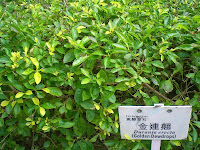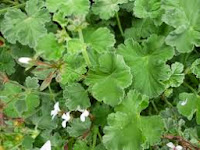Our house comes with a gardener, Rigo. He comes twice a month to attend our patio shade garden. Much of what he does is remove the clutter that falls from the trees and bushes. I asked him if it would not be better to leave the mulch on the ground, and his eyes lit up. He knows that the organic material, if left on the soil, would be beneficial to the soil and all of the plants in it. But he says everyone here considers it "basura" (trash), so they pay him to clean it up. I asked him to bag it up and let me add it to my compost pile.
Rigo on his first visit was kind enough to share with me the names of all of the plants. From my conversation with him (in Spanish), and my rough notes from that meeting, I was miraculously able to find information on some of the plants on our patio to share with you here (the single-plant photos are NOT from our patio, but I think they are better for identifying the plants).
 |
| "ficus" |
Ficus Tree (Ficus benjamina)
Back in Minnesota, this is grown as a houseplant. In this climate, it grows into a 100 foot tree, ripping up sidewalks with it's powerful roots. We have one just outside our front gate, which provides shade for everything else that grows in our front patio area.Fun fact: Ficus benjamina has been shown to effectively remove gaseous formaldehyde from indoor air.
 |
| "pochote" |
Once inside our courtyard, the centerpiece is the Pochote tree. It is easy to identify by the protective thorns on it's trunk. I have a couple of times forgotten about the sharp tips and drawn blood! Both organic markets here are named "Mercado de Pochote", and although the two markets emerged from the same organization over the years, it is not clear to us whether the markets are named after the tree (which can be found at both markets) or if there is some greater significance to the name.
 |
| "duranta" |
Ringing the Pochote in a neat hedge is what Rigo called "Duranta". The leaves and berries of the plant are toxic, and are confirmed to have killed children, dogs and cats! However, songbirds eat the fruit without ill effects. And it is said to attract butterflies and hummingbirds. Rigo suggested that I water these them most heavily of all the plants in the garden.
 |
| Pasto Liriope |
Lilyturf (Liriope muscari)
Outside the Duranta ring around the Pochote is what Rigo called "Pasto Liriope". "Pasto", I know from working in the fields at El Pedregal, means "grass". It looks like a nice ground-cover which produces a pretty purple grape hyacinth-like flower in late summer, so I guess we missed it. It is said to be "deer resistant", and grows in zone 6, for those of you fighting that battle. Roots are apparently used in traditional Chinese medicine.
 |
| "Lirio" |
What Rigo called "Lirio", this shorter cousin of the Liriope Grass (above) is a ground cover that is good down to Zone 4. Finally something that I can grow in Minnesota! But it spreads aggressively, so apparently it needs to be bordered by concrete (which makes me wonder if I have not misidentified this one). Liriope spicata filters formaldehyde, ammonia, xylene and toluene from the air. And it's good for holding the soil on a steep slope.
 |
| "Cingonia" |
Syngonium (syngonium podophyllum), Arrowhead vine, Goosefoot
Rigo sent me on a wild goose(foot) chase when he called this "Cingonia". This climber is normally considered a houseplant, but here at our place it is a vining perennial out in the garden.
Snake Plant, (Sansevieria trifasciata)
This is what Rigo called "Espada de Angel", Spanish for "Angel's Sword. Needs very little light, and almost no water in winter. Rigo told me I don't need to water this one. Fun fact: A study by NASA found that it is one of the best plants for improving indoor air quality by passively absorbing toxins such as nitrogen oxides and formaldehyde.  |
| "Yerba Santa" |
Rigo also identified for me a few potted plants, including…
 |
| "mala made", spider plant |
 |
| "Pata de Elefante", Elephant Foot |
 |
| Jade Plant |
 |
| Croton |
 |
| potted palm |
 |
| Geranium |
Putting it all together, here is the mistress of the property enjoying her garden:
 |
| Watch your fingers, Dear! |
 |
| lots of shady characters lurk in the garden. |
But don't you believe for a minute that this is the last you'll hear from me about plants, no, far from it. In addition to collecting more information about the local trees and other plants, I started a veggie and herb garden (ok, so far it's just an herb garden) on the roof, so you will probably see pictures of that soon. So for those of you who gave me encouragement after posting about the "Guage" Tree, look out!


No comments:
Post a Comment